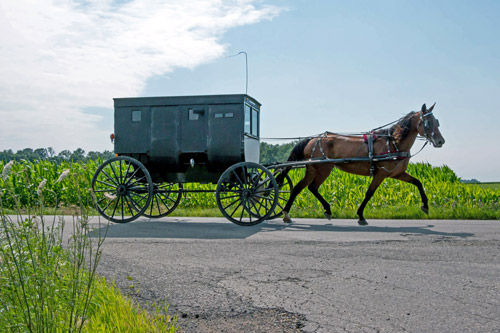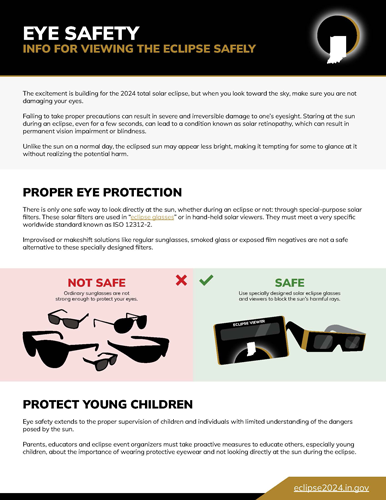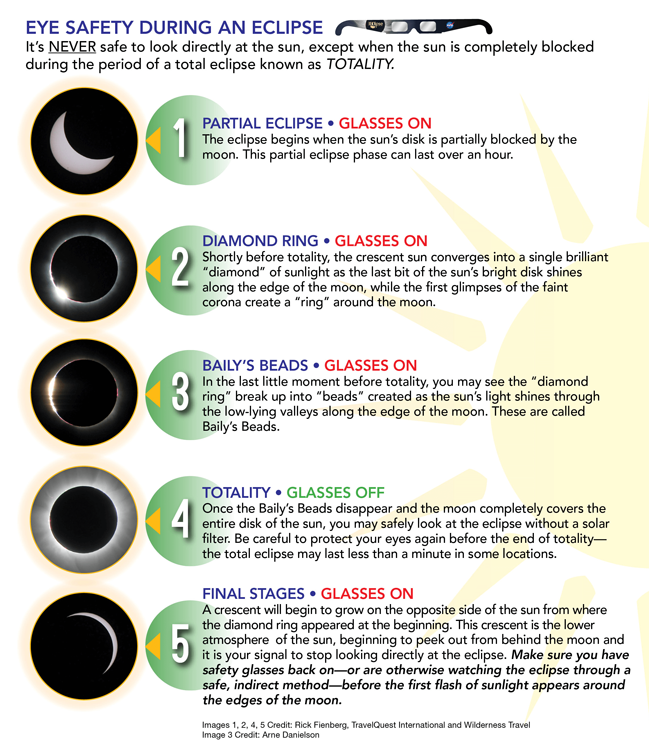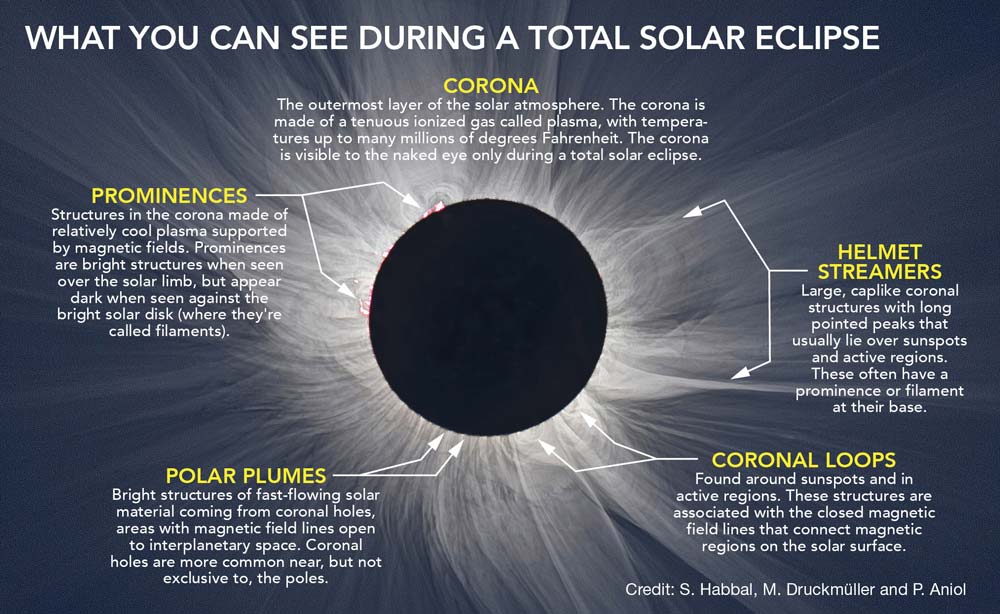A total solar eclipse is a rare and grand spectacle of nature. By following simple precautions, you can experience it safely.
- Do's and Don'ts
Do's and Don'ts
DO
- Use eclipse glasses or solar viewers that meet the ISO 12312-2 standards (sometimes written as ISO 12312-2:2015). But do not stare continuously at the sun. Take breaks and give your eyes a rest.
- Use a box pinhole viewer. Learn how to make one
- Use a pinhole projector. Learn how to make one
- Use your hands to cast shadows on the ground. Cross your hands with fingers slightly spread to create a waffle pattern. Look down and you will see the spaces between your fingers project a shadow image of the sun in a crescent shape during the partial eclipse stages.
- Look at shadows on the ground, such as beneath a leafy tree, during the partial eclipse to see the crescent sun shadows projected by the spaces between the leaves.
DON'T
- Do not look at the sun directly.*
- Do not view through regular sunglasses. No matter how dark they are, they will not protect your eyes.
- Do not use damaged eclipse sunglasses or solar viewers. If they are torn, scratched or punctured, do not use them and throw them away. If the filters are coming out of their frames, discard them.
- Do not use homemade filters.
- Do not view through welder's glass. The glass in most welding helmets is not strong enough.
- Do not view through your camera viewfinder.
- Do not view through a telescope without the proper solar filter. Do not view the telescope using your eclipse sunglasses either.
- Do not view through binoculars.
- Where to Buy Viewing Aids
Where to Buy Viewing Aids
The best way to experience the eclipse fully is to acquire a set of eclipse sunglasses. But buyer beware! Many sellers of eclipse glasses and solar viewing equipment may not have reliable products that have been properly tested and shown to be safe. Be suspicious of products that say they are approved, endorsed or certified by NASA or ISO (or use their logos), as NASA does not approve or endorse products and ISO does not certify products or allow use of its logo on them. Learn how to tell if your glasses or solar viewer are safe by buying from a reputable company and by checking that they comply with the international safety standards (ISO 12312-2).
For a trusted list of vendors selling safe eclipse viewing aids, visit the American Astronomical Society's Suppliers of Safe Solar Filters & Viewers page.
Looking for glasses with a Hoosier flair? VisitIndiana.com will be offering "Total Eclipse IN INDIANA" pairs starting in January 2024.
- How to Use Viewing Aids
How to Use Solar Eclipse Glasses or Solar Filters
Use your solar viewing aid properly to stay safe.
- Read and follow the instructions that are printed on the glasses or filter, or that came in the packaging.
- Inspect the aid before using it to make sure it is not scratched, torn, punctured or damaged in any way. If it is, throw it away and do not use it.
- If you normally wear glasses, you can keep them on and put the aid over them.
- Put the aid on before you look up at the sun, and look away from the sun before removing the aid from your eyes.
- Adults: Supervise children at all times to make sure they are using the aid properly.
- If you are in the path of totality: Remove the aid only when the moon completely covers the sun and it gets much darker outside. As soon as the sun begins to reappear, put the aid back on.
- If you are not in the path of totality: Keep your aid on at all times when viewing the eclipse. There will not be a safe time to look at the sun without it.
*Removing Your Glasses: Totality
Only when the moon completely blocks the sun (totality) can you look directly at the sun safely without viewing aids. If you are viewing the eclipse through your eclipse sunglasses, it will become pitch black when totality begins. At that time, you can remove your glasses and view the best part of the eclipse. But keep your glasses nearby. When the time of totality ends, put your glasses back on.
Remember, you must not view the eclipse with the naked eye unless you are located in the path of totality, and only during the limited time that totality occurs in your location. Permanent eye damage, including blindness, may occur if you view the eclipse without eye protection during all other times of the eclipse.
- What You Will See
What You Will See
Once you have your eclipse sunglasses or solar filter in hand, get ready for an awe-inspiring experience. If you are in the path of totality, you will be able to see the following phenomena when totality occurs:
- Pets and Animals
Animal Health and Safety Advisories


Pets
During the days leading up to, including and following the eclipse, take these pet safety tips from the Indiana State Board of Animal Health (BOAH) into account:
- Leave pets at home, where they would be safer and more comfortable — especially if pets would be in crowded areas or around other animals and unfamiliar people. They may behave unpredictably.
- Travelers should pack everything they need for pets’ comfort (food, crate, leash, medicine, toys, water, litter handling, etc.).
- Be prepared with extra supplies in case the visit continues a few days extra.
- Be sure to keep pets under your control (leash, crate, carrier).
- Be sure pets are up to date on rabies vaccination — it is Indiana law. Travel with a current certificate of veterinary inspection if coming from out-of-state. See BOAH's Indiana Entry Health Requirements page for details.


Horses
Additionally, BOAH strongly advises people not to be out on the roadways in horse-drawn buggies or carts or riding horseback during the eclipse. The totally dark and low-visibility conditions present a danger to horses and riders because they may not be visible to motor vehicle operators. Areas of Indiana where the eclipse will be the most intense (a line, roughly, from Knox County in the west to Randolph County to the east) can expect to see a high volume of vehicular traffic from visiting spectators trying to experience the eclipse — especially in rural areas. The sudden change in conditions can motivate unsafe and unpredictable behavior in the animals.
As most owners know, horses, mules, donkeys and ponies can be unpredictable under some circumstances. Rapid darkness during daylight hours can disrupt animals’ normal behaviors. Horses observed in past eclipse events have been reported to become restless, shaking their heads and tails. Sometimes animals have been reported to stop moving or exhibit extreme behaviors.
BOAH advises horse owners to prepare for the eclipse:
- Determine when the darkness of the eclipse period will begin in your area.
- Darkening skies are predicted to begin as early as 12:45 p.m. in southwestern Indiana and as late as 1:52 p.m. in eastern counties. The darkened period is predicted to extend to 4:23 p.m. in some locations.
- Total darkness will vary by location and can last up to 4.5 minutes.
- Avoid traveling on roadways during the eclipse period.
- Anyone on the roads when darkness begins should pull off the roadway and secure the horses.
- Horse owners should ensure their animals are in a secure location, such as barn, paddock or tied, during the dark period. Even non-working animals may act unpredictably.
- Additional Resources
Additional Resources
- Eye Safety Flyers
- How to View Eclipse Safely (Spanish)
- How to Check If Your Eclipse Glasses Are Safe
- How to Watch the Eclipse in Indiana
- Indiana Optometric Association: Eye Safety During a Total Solar Eclipse
- NASA: Eye Safety During Total Solar Eclipse
- Solar Retinopathy Clinical Guidelines
- Where to Watch the Eclipse in Indiana



